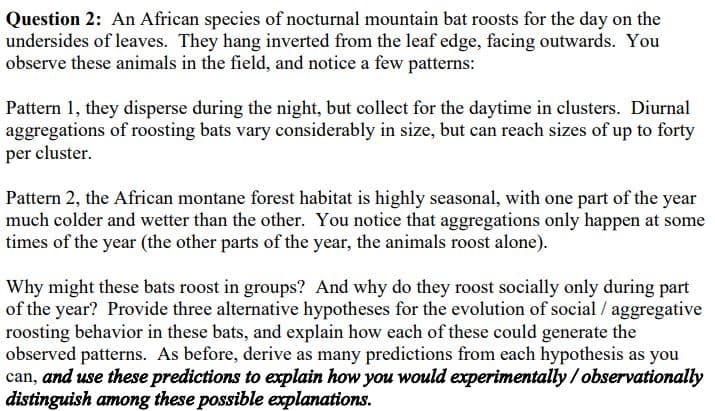Question 2: An African species of nocturnal mountain bat roosts for the day on the undersides of leaves. They hang inverted from the leaf edge, facing outwards. You observe these animals in the field, and notice a few patterns: Pattern 1, they disperse during the night, but collect for the daytime in clusters. Diurnal aggregations of roosting bats vary considerably in size, but can reach sizes of up to forty per cluster. Pattern 2, the African montane forest habitat is highly seasonal, with one part of the year much colder and wetter than the other. You notice that aggregations only happen at some times of the year (the other parts of the year, the animals roost alone). Why might these bats roost in groups? And why do they roost socially only during part of the year? Provide three alternative hypotheses for the evolution of social / aggregative roosting behavior in these bats, and explain how each of these could generate the observed patterns. As before, derive as many predictions from each hypothesis as you can, and use these predictions to explain how you would experimentally/ observationally distinguish among these possible explanations.
Question 2: An African species of nocturnal mountain bat roosts for the day on the undersides of leaves. They hang inverted from the leaf edge, facing outwards. You observe these animals in the field, and notice a few patterns: Pattern 1, they disperse during the night, but collect for the daytime in clusters. Diurnal aggregations of roosting bats vary considerably in size, but can reach sizes of up to forty per cluster. Pattern 2, the African montane forest habitat is highly seasonal, with one part of the year much colder and wetter than the other. You notice that aggregations only happen at some times of the year (the other parts of the year, the animals roost alone). Why might these bats roost in groups? And why do they roost socially only during part of the year? Provide three alternative hypotheses for the evolution of social / aggregative roosting behavior in these bats, and explain how each of these could generate the observed patterns. As before, derive as many predictions from each hypothesis as you can, and use these predictions to explain how you would experimentally/ observationally distinguish among these possible explanations.
Human Anatomy & Physiology (11th Edition)
11th Edition
ISBN:9780134580999
Author:Elaine N. Marieb, Katja N. Hoehn
Publisher:Elaine N. Marieb, Katja N. Hoehn
Chapter1: The Human Body: An Orientation
Section: Chapter Questions
Problem 1RQ: The correct sequence of levels forming the structural hierarchy is A. (a) organ, organ system,...
Related questions
Question
Give some ideas

Transcribed Image Text:Question 2: An African species of nocturnal mountain bat roosts for the day on the
undersides of leaves. They hang inverted from the leaf edge, facing outwards. You
observe these animals in the field, and notice a few patterns:
Pattern 1, they disperse during the night, but collect for the daytime in clusters. Diurnal
aggregations of roosting bats vary considerably in size, but can reach sizes of up to forty
per cluster.
Pattern 2, the African montane forest habitat is highly seasonal, with one part of the year
much colder and wetter than the other. You notice that aggregations only happen at some
times of the year (the other parts of the year, the animals roost alone).
Why might these bats roost in groups? And why do they roost socially only during part
of the year? Provide three alternative hypotheses for the evolution of social / aggregative
roosting behavior in these bats, and explain how each of these could generate the
observed patterns. As before, derive as many predictions from each hypothesis as you
can, and use these predictions to explain how you would experimentally/ observationally
distinguish among these possible explanations.
Expert Solution
This question has been solved!
Explore an expertly crafted, step-by-step solution for a thorough understanding of key concepts.
This is a popular solution!
Trending now
This is a popular solution!
Step by step
Solved in 2 steps

Knowledge Booster
Learn more about
Need a deep-dive on the concept behind this application? Look no further. Learn more about this topic, biology and related others by exploring similar questions and additional content below.Recommended textbooks for you

Human Anatomy & Physiology (11th Edition)
Biology
ISBN:
9780134580999
Author:
Elaine N. Marieb, Katja N. Hoehn
Publisher:
PEARSON

Biology 2e
Biology
ISBN:
9781947172517
Author:
Matthew Douglas, Jung Choi, Mary Ann Clark
Publisher:
OpenStax

Anatomy & Physiology
Biology
ISBN:
9781259398629
Author:
McKinley, Michael P., O'loughlin, Valerie Dean, Bidle, Theresa Stouter
Publisher:
Mcgraw Hill Education,

Human Anatomy & Physiology (11th Edition)
Biology
ISBN:
9780134580999
Author:
Elaine N. Marieb, Katja N. Hoehn
Publisher:
PEARSON

Biology 2e
Biology
ISBN:
9781947172517
Author:
Matthew Douglas, Jung Choi, Mary Ann Clark
Publisher:
OpenStax

Anatomy & Physiology
Biology
ISBN:
9781259398629
Author:
McKinley, Michael P., O'loughlin, Valerie Dean, Bidle, Theresa Stouter
Publisher:
Mcgraw Hill Education,

Molecular Biology of the Cell (Sixth Edition)
Biology
ISBN:
9780815344322
Author:
Bruce Alberts, Alexander D. Johnson, Julian Lewis, David Morgan, Martin Raff, Keith Roberts, Peter Walter
Publisher:
W. W. Norton & Company

Laboratory Manual For Human Anatomy & Physiology
Biology
ISBN:
9781260159363
Author:
Martin, Terry R., Prentice-craver, Cynthia
Publisher:
McGraw-Hill Publishing Co.

Inquiry Into Life (16th Edition)
Biology
ISBN:
9781260231700
Author:
Sylvia S. Mader, Michael Windelspecht
Publisher:
McGraw Hill Education